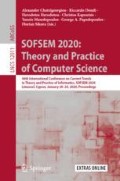Abstract
String representations of objects are used for many purposes during software development, including debugging and logging. In Java, each class can define its own string representation by overriding the toString method. Despite their usefulness, these methods have been neglected by researchers so far. In this paper, we describe an empirical study of toString methods performed on a corpus of Java files. We are asking what portion of classes defines toString, how are these methods called, and what do they look like. We found that the majority of classes do not override the default (not very useful) implementation. A large portion of the toString method calls is implicit (using a concatenation operator). The calls to toString are used for nested string representation building, exception handling, in introspection libraries, for type conversion, and in test code. A typical toString implementation consists of literals, field reads, and string concatenation. Around one third of the string representation definitions is schematic. Half of such schematic implementations do not include all member variables in the printout. This fact motivates the future research direction – fully automated generation of succinct toString methods.
Access this chapter
Tax calculation will be finalised at checkout
Purchases are for personal use only
References
Bezirgiannis, N., Jeuring, J., Leather, S.: Usage of generic programming on hackage: experience report. In: Proceedings of the 9th ACM SIGPLAN Workshop on Generic Programming, WGP 2013, pp. 47–52. ACM, New York (2013). https://doi.org/10.1145/2502488.2502494
Chiş, A., Nierstrasz, O., Syrel, A., Gîrba, T.: The moldable inspector. In: 2015 ACM International Symposium on New Ideas, New Paradigms, and Reflections on Programming and Software, Onward! 2015, pp. 44–60. ACM, New York (2015). https://doi.org/10.1145/2814228.2814234
Dyer, R., Rajan, H., Nguyen, H.A., Nguyen, T.N.: Mining billions of AST nodes to study actual and potential usage of Java language features. In: Proceedings of the 36th International Conference on Software Engineering, ICSE 2014, pp. 779–790. ACM, New York (2014). https://doi.org/10.1145/2568225.2568295
Kalliamvakou, E., Gousios, G., Blincoe, K., Singer, L., German, D.M., Damian, D.: The promises and perils of mining GitHub. In: Proceedings of the 11th Working Conference on Mining Software Repositories, MSR 2014, pp. 92–101. ACM, New York (2014). https://doi.org/10.1145/2597073.2597074
Lemay, M.J.: Understanding Java usability by mining GitHub repositories. In: 9th Workshop on Evaluation and Usability of Programming Languages and Tools (PLATEAU 2018). OpenAccess Series in Informatics (OASIcs), vol. 67, pp. 2:1–2:9. Schloss Dagstuhl-Leibniz-Zentrum fuer Informatik, Dagstuhl, Germany (2019). https://doi.org/10.4230/OASIcs.PLATEAU.2018.2
Ma, H., Amor, R., Tempero, E.: Usage patterns of the Java standard API. In: Proceedings of the XIII Asia Pacific Software Engineering Conference, APSEC 2006, pp. 342–352. IEEE Computer Society, Washington (2006). https://doi.org/10.1109/APSEC.2006.60
Pawlak, R., Monperrus, M., Petitprez, N., Noguera, C., Seinturier, L.: Spoon: a library for implementing analyses and transformations of Java source code. Softw. Pract. Exp. 46(9), 1155–1179 (2016). https://doi.org/10.1002/spe.2346
Qiu, D., Li, B., Leung, H.: Understanding the API usage in Java. Inf. Softw. Technol. 73(C), 81–100 (2016). https://doi.org/10.1016/j.infsof.2016.01.011
Rozenberg, D., Beschastnikh, I.: Templated visualization of object state with Vebugger. In: Proceedings of the 2014 Second IEEE Working Conference on Software Visualization, VISSOFT 2014, pp. 107–111. IEEE Computer Society, Washington (2014). https://doi.org/10.1109/VISSOFT.2014.26
Schwarz, N.: DoodleDebug, objects should sketch themselves for code understanding. In: 5th Workshop on Dynamic Languages and Applications, DYLA 2011 (2011)
Sulír, M., Juhár, J.: Draw this object: a study of debugging representations. In: Proceedings of the Conference Companion of the 3rd International Conference on Art, Science, and Engineering of Programming, pp. 20:1–20:11. ACM (April 2019). https://doi.org/10.1145/3328433.3328454
Sulír, M., Porubän, J.: Augmenting source code lines with sample variable values. In: Proceedings of the 2018 26th IEEE/ACM International Conference on Program Comprehension (ICPC), pp. 344–347 (May 2018). https://doi.org/10.1145/3196321.3196364
Tempero, E., et al.: The Qualitas Corpus: a curated collection of Java code for empirical studies. In: Proceedings of the 2010 Asia Pacific Software Engineering Conference, APSEC 2010, pp. 336–345. IEEE Computer Society, Washington (2010). https://doi.org/10.1109/APSEC.2010.46
Terra, R., Miranda, L.F., Valente, M.T., Bigonha, R.S.: Qualitas.class corpus: a compiled version of the Qualitas Corpus. SIGSOFT Softw. Eng. Notes 38(5), 1–4 (2013). https://doi.org/10.1145/2507288.2507314
Wohlin, C., Runeson, P., Höst, M., Ohlsson, M.C., Regnell, B., Wesslén, A.: Experimentation in Software Engineering. Springer, Berlin (2012). https://doi.org/10.1007/978-3-642-29044-2
Xu, W., Huang, L., Fox, A., Patterson, D., Jordan, M.I.: Detecting large-scale system problems by mining console logs. In: Proceedings of the ACM SIGOPS 22Nd Symposium on Operating Systems Principles, SOSP 2009, pp. 117–132. ACM, New York (2009). https://doi.org/10.1145/1629575.1629587
Acknowledgments
This work was supported by Project VEGA No. 1/0762/19 Interactive pattern-driven language development. This work was also supported by FEI TUKE Grant no. FEI-2018-57 “Representation of object states in a program facilitating its comprehension”.
Author information
Authors and Affiliations
Corresponding author
Editor information
Editors and Affiliations
Rights and permissions
Copyright information
© 2020 Springer Nature Switzerland AG
About this paper
Cite this paper
Sulír, M. (2020). String Representations of Java Objects: An Empirical Study. In: Chatzigeorgiou, A., et al. SOFSEM 2020: Theory and Practice of Computer Science. SOFSEM 2020. Lecture Notes in Computer Science(), vol 12011. Springer, Cham. https://doi.org/10.1007/978-3-030-38919-2_39
Download citation
DOI: https://doi.org/10.1007/978-3-030-38919-2_39
Published:
Publisher Name: Springer, Cham
Print ISBN: 978-3-030-38918-5
Online ISBN: 978-3-030-38919-2
eBook Packages: Computer ScienceComputer Science (R0)

